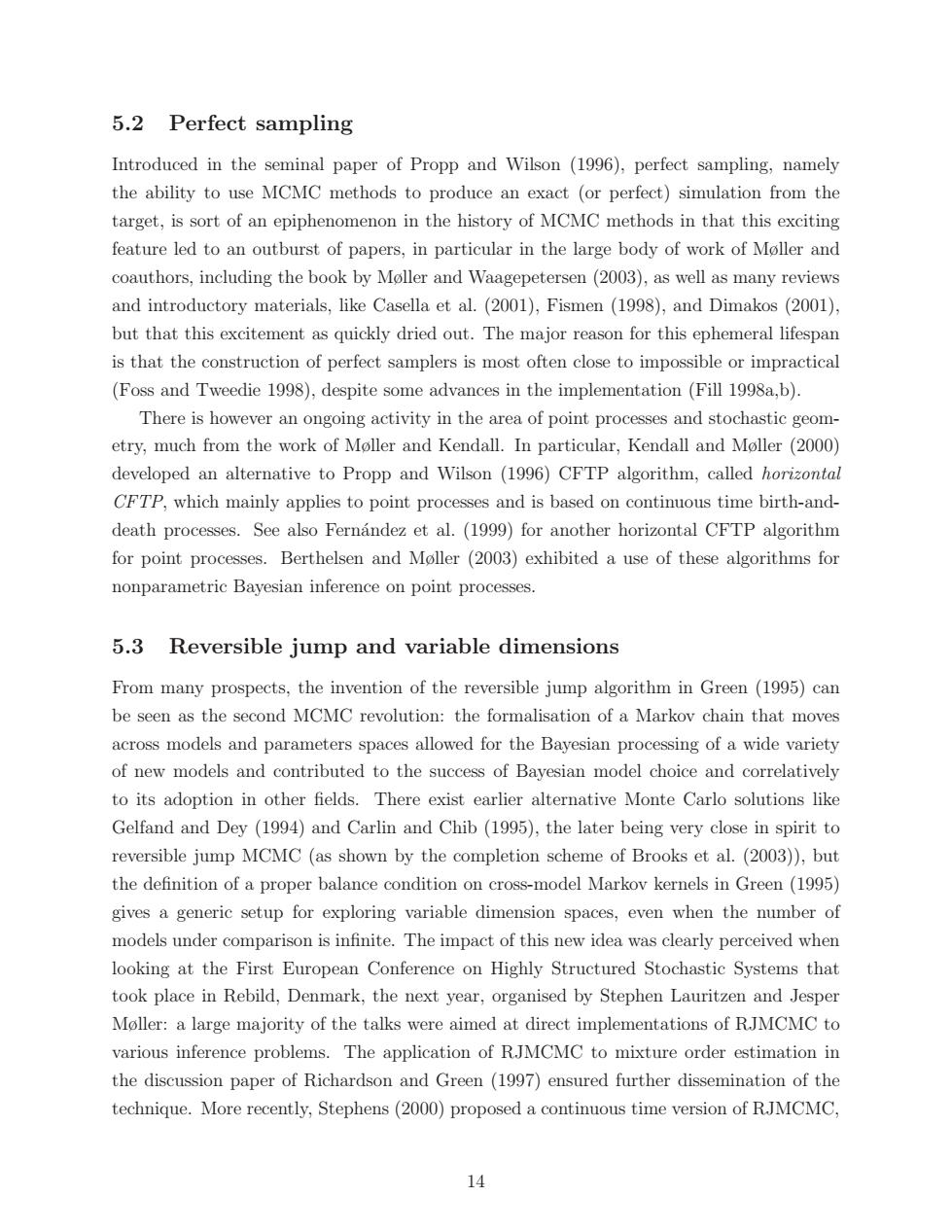正在加载图片...

5.2 Perfect sampling Introduced in the seminal paper of Propp and Wilson (1996),perfect sampling,namely the ability to use MCMC methods to produce an exact (or perfect)simulation from the target,is sort of an epiphenomenon in the history of MCMC methods in that this exciting feature led to an outburst of papers,in particular in the large body of work of Moller and coauthors,including the book by Moller and Waagepetersen (2003),as well as many reviews and introductory materials,like Casella et al.(2001),Fismen (1998),and Dimakos (2001), but that this excitement as quickly dried out.The major reason for this ephemeral lifespan is that the construction of perfect samplers is most often close to impossible or impractical (Foss and Tweedie 1998),despite some advances in the implementation (Fill 1998a,b) There is however an ongoing activity in the area of point processes and stochastic geom- etry,much from the work of Moller and Kendall.In particular,Kendall and Moller (2000) developed an alternative to Propp and Wilson (1996)CFTP algorithm,called horizontal CFTP,which mainly applies to point processes and is based on continuous time birth-and- death processes.See also Fernandez et al.(1999)for another horizontal CFTP algorithm for point processes.Berthelsen and Moller (2003)exhibited a use of these algorithms for nonparametric Bayesian inference on point processes. 5.3 Reversible jump and variable dimensions From many prospects,the invention of the reversible jump algorithm in Green (1995)can be seen as the second MCMC revolution:the formalisation of a Markov chain that moves across models and parameters spaces allowed for the Bayesian processing of a wide variety of new models and contributed to the success of Bayesian model choice and correlatively to its adoption in other fields.There exist earlier alternative Monte Carlo solutions like Gelfand and Dey (1994)and Carlin and Chib (1995),the later being very close in spirit to reversible jump MCMC (as shown by the completion scheme of Brooks et al.(2003)),but the definition of a proper balance condition on cross-model Markov kernels in Green (1995) gives a generic setup for exploring variable dimension spaces,even when the number of models under comparison is infinite.The impact of this new idea was clearly perceived when looking at the First European Conference on Highly Structured Stochastic Systems that took place in Rebild,Denmark,the next year,organised by Stephen Lauritzen and Jesper Moller:a large majority of the talks were aimed at direct implementations of RJMCMC to various inference problems.The application of RJMCMC to mixture order estimation in the discussion paper of Richardson and Green (1997)ensured further dissemination of the technique.More recently,Stephens(2000)proposed a continuous time version of RJMCMC, 145.2 Perfect sampling Introduced in the seminal paper of Propp and Wilson (1996), perfect sampling, namely the ability to use MCMC methods to produce an exact (or perfect) simulation from the target, is sort of an epiphenomenon in the history of MCMC methods in that this exciting feature led to an outburst of papers, in particular in the large body of work of Møller and coauthors, including the book by Møller and Waagepetersen (2003), as well as many reviews and introductory materials, like Casella et al. (2001), Fismen (1998), and Dimakos (2001), but that this excitement as quickly dried out. The major reason for this ephemeral lifespan is that the construction of perfect samplers is most often close to impossible or impractical (Foss and Tweedie 1998), despite some advances in the implementation (Fill 1998a,b). There is however an ongoing activity in the area of point processes and stochastic geometry, much from the work of Møller and Kendall. In particular, Kendall and Møller (2000) developed an alternative to Propp and Wilson (1996) CFTP algorithm, called horizontal CFTP, which mainly applies to point processes and is based on continuous time birth-anddeath processes. See also Fern´andez et al. (1999) for another horizontal CFTP algorithm for point processes. Berthelsen and Møller (2003) exhibited a use of these algorithms for nonparametric Bayesian inference on point processes. 5.3 Reversible jump and variable dimensions From many prospects, the invention of the reversible jump algorithm in Green (1995) can be seen as the second MCMC revolution: the formalisation of a Markov chain that moves across models and parameters spaces allowed for the Bayesian processing of a wide variety of new models and contributed to the success of Bayesian model choice and correlatively to its adoption in other fields. There exist earlier alternative Monte Carlo solutions like Gelfand and Dey (1994) and Carlin and Chib (1995), the later being very close in spirit to reversible jump MCMC (as shown by the completion scheme of Brooks et al. (2003)), but the definition of a proper balance condition on cross-model Markov kernels in Green (1995) gives a generic setup for exploring variable dimension spaces, even when the number of models under comparison is infinite. The impact of this new idea was clearly perceived when looking at the First European Conference on Highly Structured Stochastic Systems that took place in Rebild, Denmark, the next year, organised by Stephen Lauritzen and Jesper Møller: a large majority of the talks were aimed at direct implementations of RJMCMC to various inference problems. The application of RJMCMC to mixture order estimation in the discussion paper of Richardson and Green (1997) ensured further dissemination of the technique. More recently, Stephens (2000) proposed a continuous time version of RJMCMC, 14